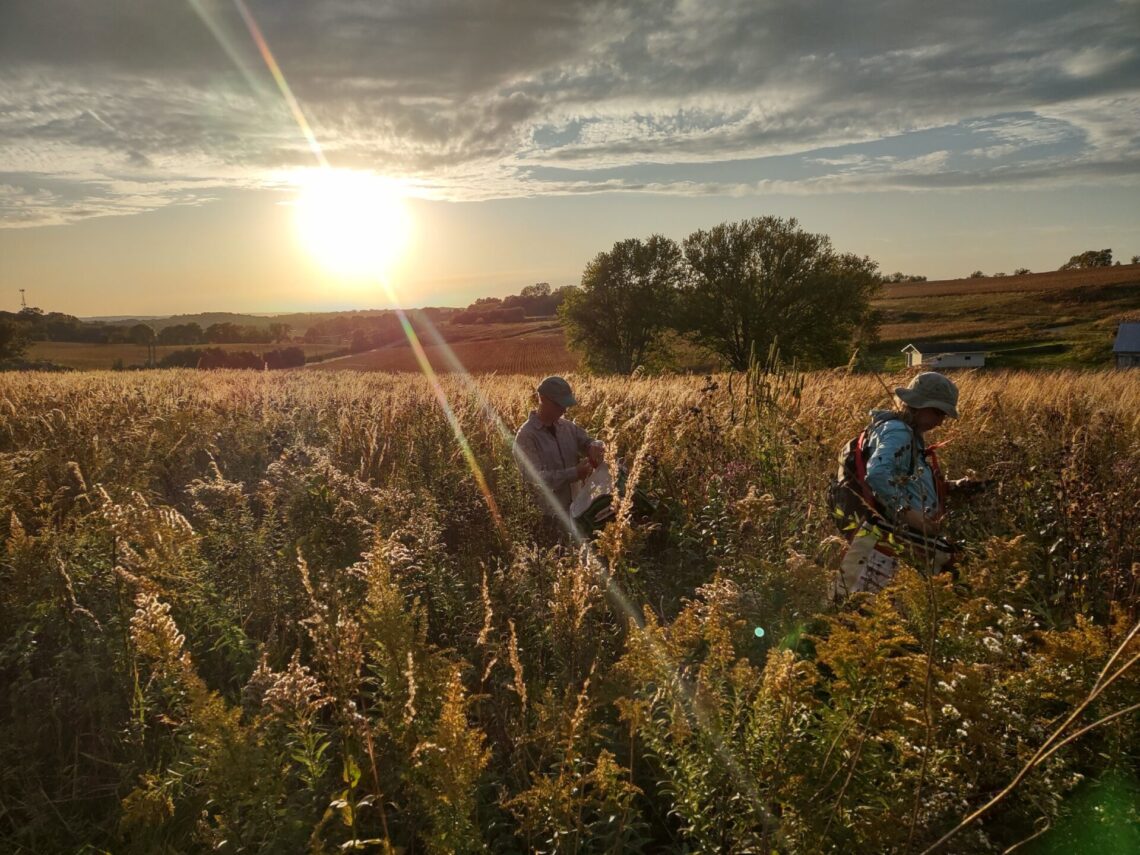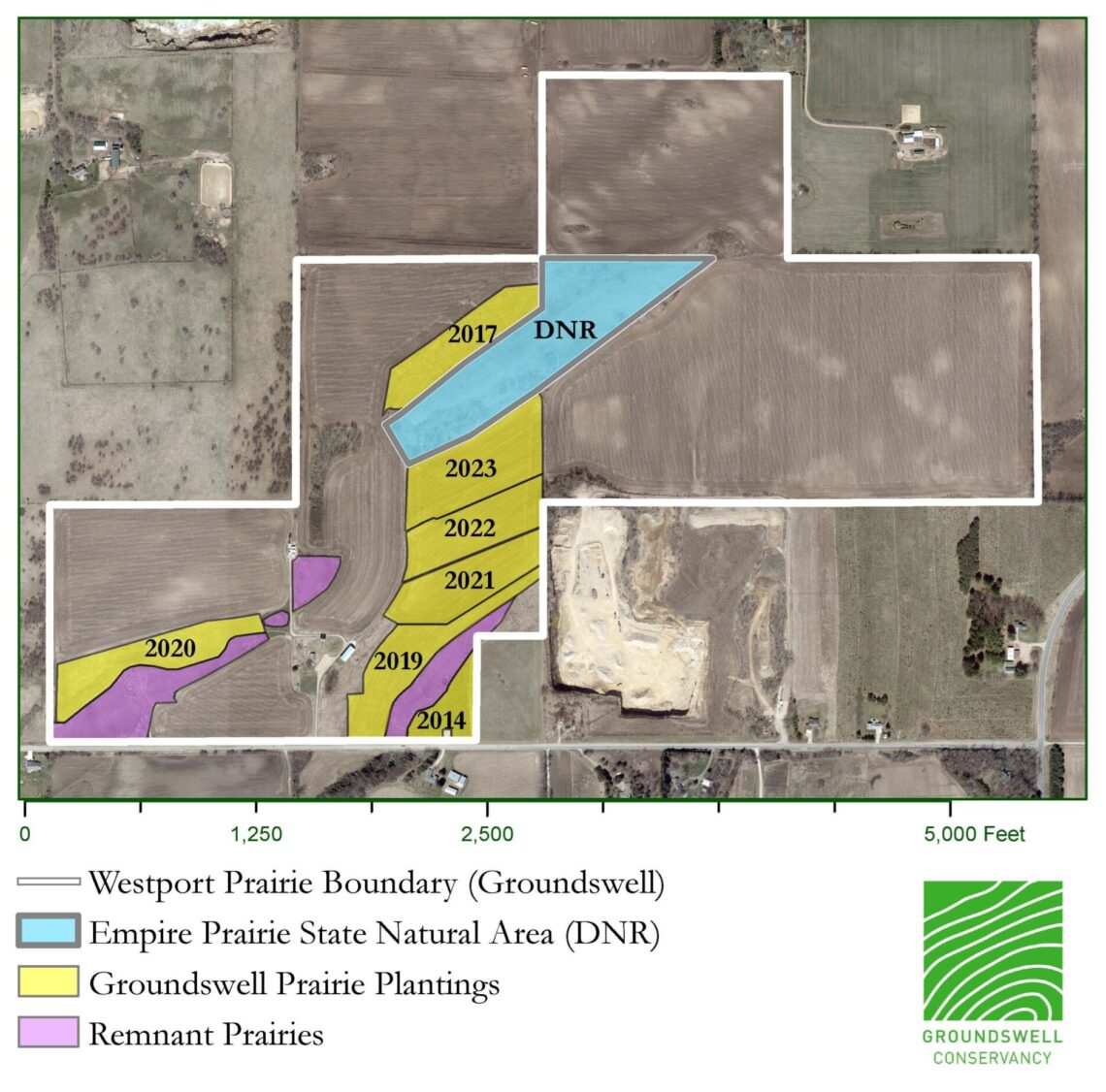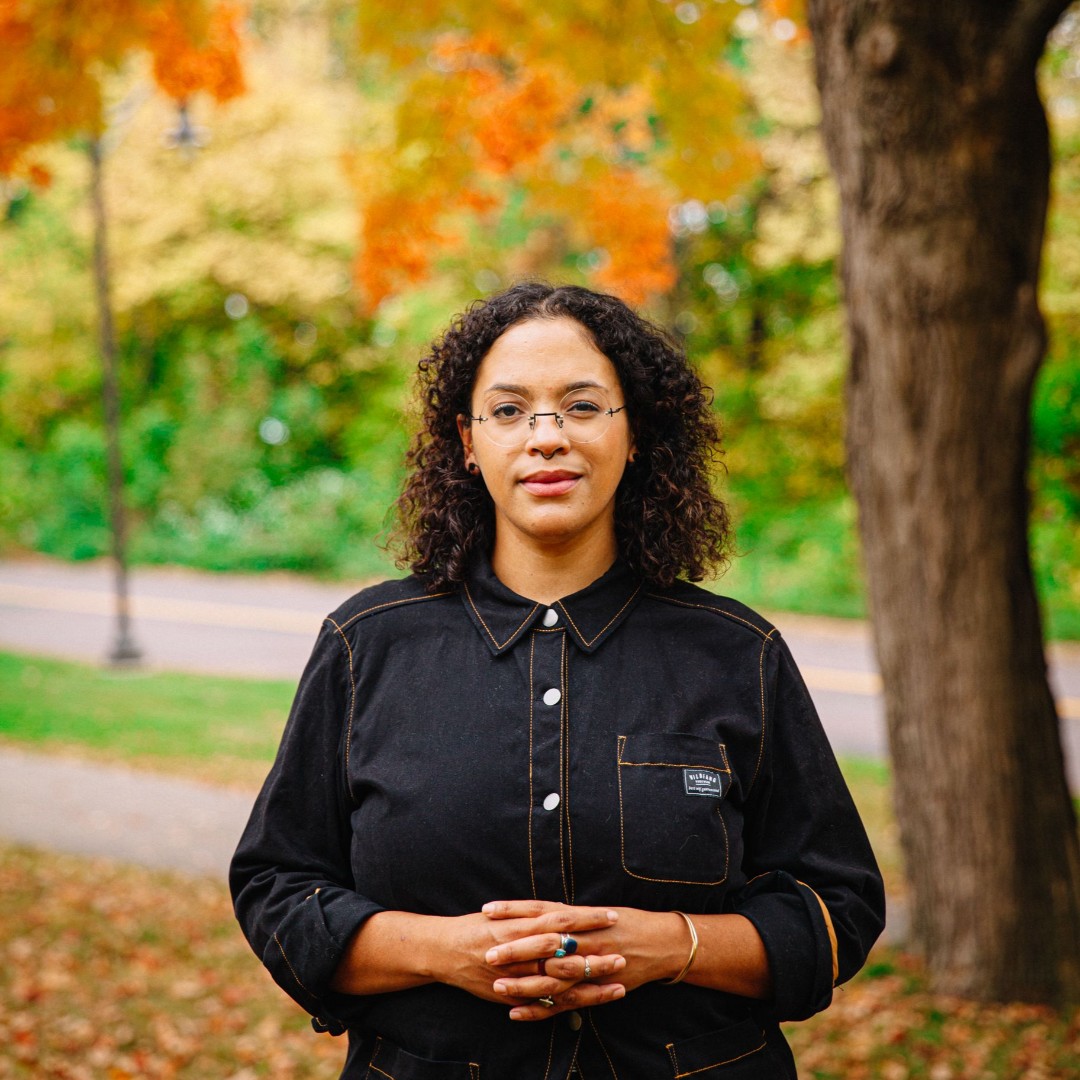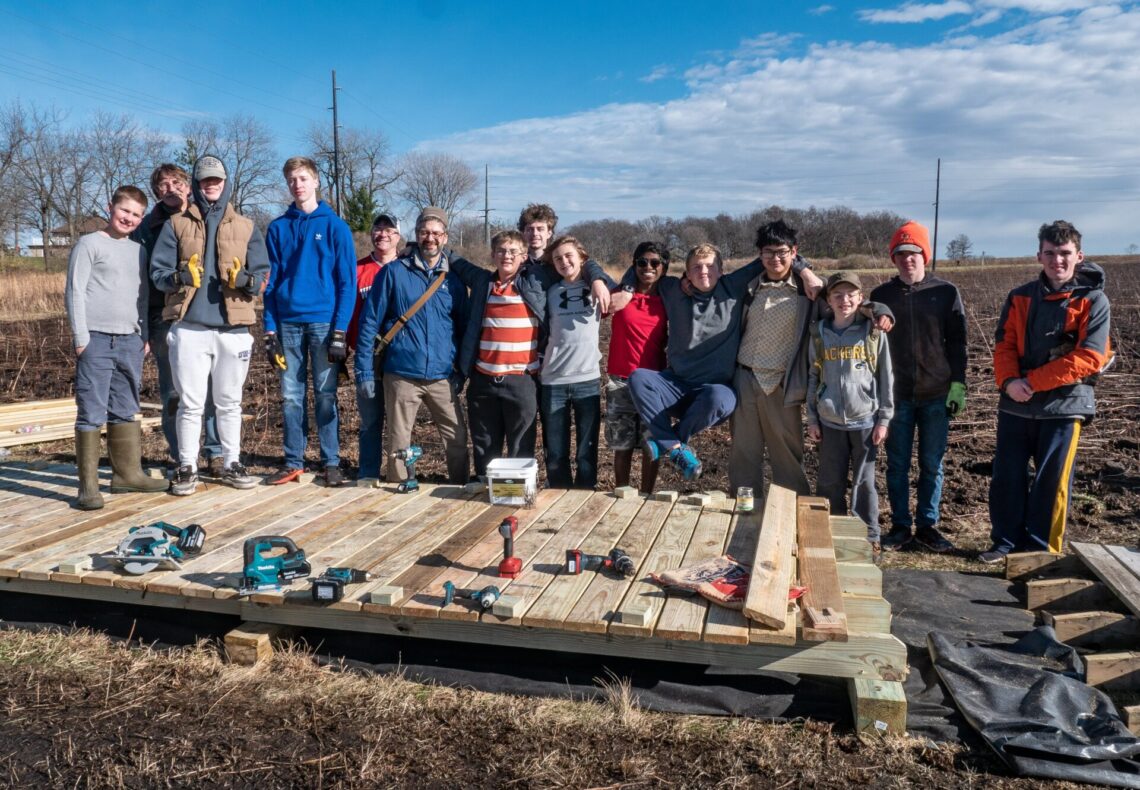Groundswell’s Westport Prairie is a 227-acre wildlife area east of Waunakee that is open to the public. In the middle of it, Wisconsin DNR owns the 14-acre glacial drumlin as a State Natural Area. The drumlin is home to over 100 plant species and is a prime example of a healthy shortgrass prairie. This prairie is only a small part of what used to be the Empire Prairie, that covered up to 150,000 acres in Dane and Columbia Counties.
When Groundswell first purchased the land surrounding the State Natural Area, most of the land was farmed. Scattered around were a few small remnant prairies just a couple of acres in size. These prairies are steep, rocky, and impossible to farm. That’s why they remain today.
Groundswell has a goal of turning all of the farmland (over 200 acres) into native prairie, and we’re doing well! Every year, we take more than 5 acres of farmland out of use and plant it to native flowers and grasses. We use seed collected on-site and from other remnant prairies in the area. This type of prairie planting is called “local genotype restoration” because we use seeds from the local area.
From May to November of each year, we collect prairie seeds with the help of volunteers, interns, conservation crews, and a part-time seed collector that we hire in the fall. We also get seeds donated from the Wisconsin DNR as well as from Southern Wisconsin Bird Alliance.
In winter, when it’s snowy, we sow all the seeds collected during the year and start planning for the next year’s planting.
Our most recent planting from this winter (listed as ‘2023’ on the map) was a historic planting. It was the largest yet at Westport Prairie, covering 6.5 acres. Also, it connects two remnant prairies that used to be one but were separated over time due to farming (the pink remnant prairie to the south with the DNR-owned area in blue to the north).
With each prairie that we plant our seed source grows. This means the size of our plantings will also grow. Next year, we plan to plant 7.5 acres, and 9.5 acres the year after that. Piece by piece, our goal is to bring back a lost landscape by creating habitat that will live on the landscape forever.
Over the last five years, we’ve converted 25 acres (5 acres per year) of agricultural land to native tallgrass prairie at Westport Prairie! We do this by collecting prairie seed from nearby remnant prairies that once made up the historic Empire Prairie. While this is an impressive accomplishment worth celebrating, we still have ~175 acres of agricultural land at Westport to plant to prairie. The more we plant, the more seed sources we have to collect from. This means our plantings will grow larger and larger each year. In fact, this winter our planting will be 6.5 acres; next year it will be 7+ acres.
So how do we collect enough seed to make these planting possible? A decent amount is collected by our summer interns and monthly volunteers. Starting about three years ago, the bulk has been collected by Kaylee Nelsen. From late September through November, Kaylee spends evenings and weekends drying, processing, and weighing the seeds of each prairie plant species. She’s got a knack for this kind of work, and it’s very impressive! Most people have trouble identifying plants in full bloom, but Kaylee can identify them when they’re all brown and shriveled up. Because of the important work Kaylee does for Groundswell and for conservation, we want to highlight her here. So, here’s what Kaylee has to say:
“This fall will mark my third season helping collect native seeds at Westport Prairie as part of Groundswell’s effort to convert cropland back into native prairie. When I was first recommended for the role, I had just finished my master’s degree in environmental conservation from the Nelson Institute and was looking for something to occupy my time while searching for a full-time job. The calming and grounding nature of native seed collecting quickly grew on me, and by November I was fully enamored with the complexity of the remnants along with the ambiance of sights, sounds, and smells. The following spring, I was employed full-time working in conservation with Good Oak Ecological Services and continued to collect seeds part-time for Groundswell in the fall. There is a great quote in the book Noah’s Garden by Sara Stein that poetically sums up why conservation is important to me.
‘Remove the pheasant’s cover or the butterfly’s flower and you have erased its space. The less variety of habitat the landscape offers, the less space there is until, when all is mowed, even an expanse the size of a golf course becomes just a hole in the world.’
I am grateful to have this opportunity to work with the wonderful Groundswell staff and volunteers to fill some of the holes in our world.” –Kaylee Nelsen
Groundswell is planting 6.5 acres of prairie on Saturday, December 9th from 9am-noon at Westport Prairie (5208 Bong Road, Waunakee) and we’d love for you to join. This will be an historic planting as it will reconnect the drumlin with our remnant prairie east of the tobacco barn. These prairies have been separated for a very long time, so reuniting them will be a grand accomplishment!
|
|
|
Brandon Mann, Easement Stewardship Manager, interviews John Meyer about farming and soil health as a part of our Soil Health Initiative.
1. Why did you enter farming?
I got a degree in Agricultural Engineering with a soil and water conservation emphasis from UW Platteville in 1977. I worked for a public utility in farmstead electrification in SW Wis from 1977 to 1981. I grew up on a diverse farm and saw what successful farmers were doing and I thought I could do that. It’s a good place to raise a family and my in-laws were interested in selling out. The opportunity was there.
a. What is your evolution as a farmer?
We started out moldboard plowing and working the soil many times to prepare a seedbed. The second year we went to a chisel plow and offset disk and eliminated a lot of trips and saved soil and moisture by doing so. We ran a small dairy herd on shares at the start. From 1981 to 1996 we milked 45 to 50 cows annually. In ‘96 we acquired a 70-cow barn, and we eventually expanded our cow numbers to 110 on the 2 farms. We had strict crop rotations and 50% of our crops were alfalfa/grass mixes. We alternated strips of row crops with hay. We were among the first to officially adopt a nutrient management plan. Most of that plan we were already doing. Managing nutrients saves money and makes you more efficient. It also prevents runoff of valuable nutrients.
b. You seem to be adaptable and like a challenge.
I am able to put a pencil to decisions. Do a cost benefit analysis with a payback. Consider the soil too. Leave a good farm for the grandchildren.
c. How has that influenced how you farm?
An economic analysis allows me to put concrete values on most decisions. Some things are not measurable, so I take that into account too. Leaving the land better than you found it has value. My father-in-law told me that.
2. What management practices related to soil health/conservation are you using on your farm and why?
We always kept hay in our rotation, and we included grass for 30 years. The contour strips and hay strips conserves soil. Our son Jered has taken over the farm and the conservation practices also. He converted to 100% no till. The no till enhances soil conservation and greatly reduces carbon needs also. He reads and talks to others.
a. What changes have you observed in your soil since adopting those practices?
I believe the topsoil depth has improved, especially on the north farm which we purchased in 1996 (original farm was 1988). The north farm saves and holds water better and the topsoil is deeper.
3. Do you speak with other farmers who’ve adopted things like cover cropping, no-till, diversifying their crop rotations, or rotational grazing?
We did a fair amount of rotational grazing in 2015 when our son took a more active role, and it helps with the forage quality on maintains the stands of grass too. We consulted other farmers. We have since downsized the beef cow herd. Our son researched the no till practices with neighbors. We are considering cover crops. It will be especially needed if we move away from hay crops. In the past, we used winter wheat as an alternative crop. It works much the same as a fall planted cover crop. But it provides summer grain and straw while controlling erosion.
a. What do they have to say about it?
Most farmers are aware of the told in the toolbox. May will ask how it works for you, just as we have asked others the same question.
4. What are your thoughts on the intersection of weather extremes and farming?
I have witnessed the longer growing seasons and I adjusted the maturity of my chosen hybrids to take advantage of the longer growing season. We get better yields. We are not the hottest place in the US but we definitely see the changes in temps. There is no debate of the increase of degree days of heat. I will not debate the causes, but I accept the facts. I see the corn belt moving north. The problem with that is the rolling hills of the SW Wisconsin is not conducive to continuous row crops without adjustments in practices. Those adjustments are no till, cover crops, and staying on the contour.
5. What positive trends have you seen develop in agriculture?
I think economics dictates good conservation practices. What I have witnessed in 40+ years of farming is better conservation, and even larger farms embracing conservation. Large farms are doing cover crops, and no till. Farmers are using nutrient management plans and rotations of crops. Farmers hire professional services and scouting for pests. And even though GMO’s get a bad rap, GMOs have greatly reduced the reliance on chemicals and pesticides. I used to plant conventional seeds and used chemical protections. Then I wore a rubber suit in order to safely plant and apply chemicals. I do not need to do this anymore. Three grains of sand sized particles of pesticide could kill a person almost instantly. I am glad to see that need is gone.
To learn more about the Soil Health Initiative, click here to read an update from Brandon Mann.
Groundswell is now the proud owner of a brand-new tractor and mower, and we couldn’t have done it without you! We are happy to support a local business with this purchase too. Each year we plant more and more acres of prairie at Westport Prairie. Having a tractor is going to make land management so much easier. This New Holland Workmaster 50 will be put to good use for many years to come. It will primarily be used to perform maintenance mowing in our newly planted prairies. Each new prairie should be mowed two to three times per year for the first couple of years to eliminate weeds and allow sunlight to reach the tiny prairie seedlings. The tractor will also be used to mow the various trails at Westport Prairie. We’re so excited to get outside and put it to good use for wildlife habitat!
Tractor Naming Contest Details
Groundswell needs help naming the tractor! The tractor naming contest will include three rounds.
Round 1 – Open Name Suggestions
Send your name suggestions to us in the form below.
Round 1 will be open until Tuesday, August 29th.
Round 2 – Staff Top Five Choices
Groundswell staff will choose our top five favorite names from your suggestions.
Round 2 will be conducted by staff from Wednesday, August 30th to Friday, September 1st.
Round 3 – Final Voting by You
Vote on your favorite name from the staff’s top five choices, and the final name will be decided by voters!
Round 3 will be open from Saturday, September 2nd to Wednesday, September 6th.
And the winning name is…
Elmow!
A special thank you to these supporters for making the purchase of a tractor and mower possible!
- Terri Beck-Engel
- Scott and Dawn Bethke
- Lois Curtiss
- Phyllis Davis
- Mike Foy and Carrie Morgan
- Karl Gutknecht & Susan Hunt
- Green Bay Packers Foundation
- Stan Kanter
- Jeff Lange & Dolly Marsh
- Sharifa Merchant
- Stefanie Moritz & Vince Jenkins
- Ursula Muehllehner
- William & Virginia Nelson
- Wayne & Jackie Pauly
- Cathy Schmitz and her Facebook fundraiser contributors
- Kelly and Linda Sweeney
- Willi Van Haren
- Pat Watson
- Tracy Wiklund
- Tom Wilson
- James & Susan Zerwick
In the next 15 years, farmland in the United States will face major transitions and challenges. The average farmer is over 57 years old, and many farmers do not have heirs who want to take over their farms. Approximately 90% of farmland is owned by non-farming owners, and the cost of farmland continues to rise. On top of that, the most productive farmland is often the most attractive to developers.
To facilitate and address these challenges, Groundswell is creating a pipeline to farmland ownership for Black, Indigenous, and People of Color farmers and land seekers using the Buy, Protect, Sell (BPS) model. Read the successful BPS story by American Farmland Trust and Renewing the Countryside.
If you’re a farmland owner or know a farmland owner, you can help leave a legacy. To read more about farmland transition options, click here.
The Linden Cohousing Farmers Market will be back for a fourth year of bringing fresh, locally grown food to the eastside of Madison. When you shop at the Linden Cohousing Farmers Market, you are directly supporting farmers and entrepreneurs of color in our community.
The market will be held at 2082 Winnebago Street, every Thursday 3:00 – 6:00 pm, starting on May 25, 2023 and ending on September 28, 2023.
Thank you to our market sponsor TASC!
As 2022 comes to a close, we’re reflecting on another year of connecting people to nature. This year, we had the pleasure of connecting people to nature through the written word.
We collaborated with two local poets as part of the Writing the Land project to honor local land through poetry. They wrote poems inspired by two of the special places we protect – Westport Prairie and Patrick Marsh.
Poet Lisa Marie Brimmer wrote poems inspired by Westport Prairie.
Angie Trudell Vasquez, City of Madison Poet Laureate, wrote poems inspired by Patrick Marsh.
Read the poems by clicking the links above. And check out the videos below of Lisa Marie and Angie reading their poems.
Through the Writing the Land project, Lisa Marie and Angie emphasized the importance of individual connection to land and place. We hope these poems inspire you to visit these special places and think about their protection in a new way.
A huge thank you to Lisa Marie and Angie for sharing their time, talent, and commitment to conservation with us. They’ve both been a pleasure to work with and we’re honored to have them bring a fresh perspective to our protected lands.
If you have any questions, comments, or reactions to this project, please feel free to reach out to Liz at liz@groundswellconservancy.org.
Hiking at Patrick Marsh just got more accessible (and less muddy) thanks to local Boy Scout Nick Parks! Nick, of Boy Scout Troop 47, recently extended a boardwalk by ~35 feet for his Eagle Scout Project. The boardwalk covers a muddy section of trail near the south entrance of Patrick Marsh. Thanks to the hard work of Nick and a crew of volunteers, visitors will have an easier time traversing this section of path.
Check out more photos from the boardwalk build here.
Thank you to Groundswell supporters Ann and Ron Semmann and Rex Owens (who gave in memory of his late wife Lynette Owens) for funding this project.
Learn more about how this project happened in this video from Sun Prairie News.
The Linden Cohousing Farmers Market is back and better than ever! The market opens today, May 26, and will run through September 22, 2022. It will be open every Thursday from 3:00 to 6:00 p.m. at the Linden Cohousing parking lot (located at 2082 Winnebago Street).
This year the market is expanding to include more producers of color and a food cart!
The farmers market was created to be inclusive and accessible to small farm businesses that were facing barriers. As we coordinate with new small producers operating out of the FEED Kitchen, customers will see different vendors throughout the season selling items like fresh egg rolls and homemade salsa.
Thank you to our sponsor TASC for supporting the market again this year!






